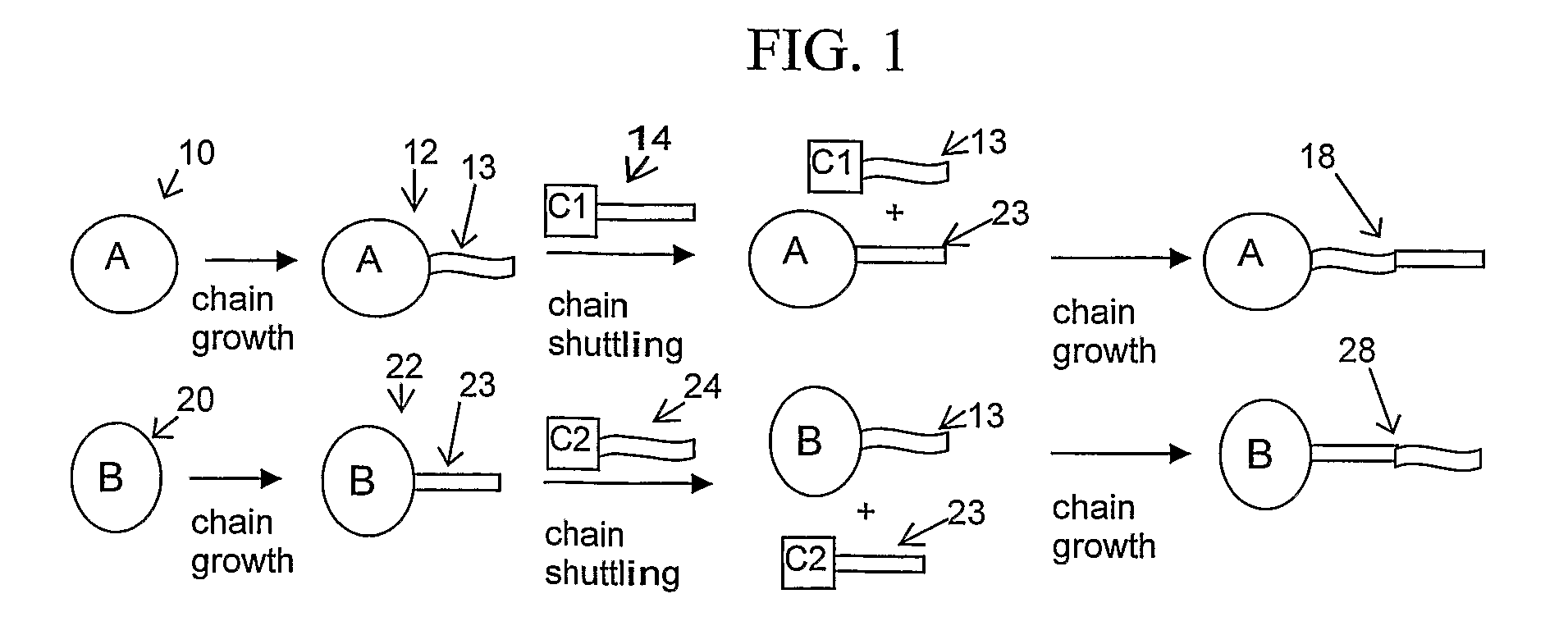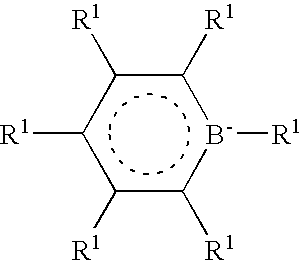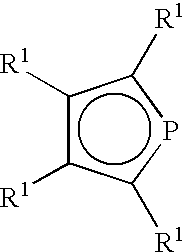Catalyst composition comprising shuttling agent for ethylene copolymer formation
a technology of ethylene copolymer and composition, which is applied in the direction of catalyst activation/preparation, physical/chemical process catalyst, chemical/physical process, etc., can solve the problems of poor process economics, limited monomer types that can be usefully employed in such methods, and low efficiency
- Summary
- Abstract
- Description
- Claims
- Application Information
AI Technical Summary
Benefits of technology
Problems solved by technology
Method used
Image
Examples
specific embodiments
[0590]The following specific embodiments of the invention and combinations thereof are especially desirable and hereby delineated in order to provide detailed disclosure for the appended claims.
[0591]1. A composition comprising the admixture or reaction product resulting from combining:
[0592](A) a first olefin polymerization catalyst,
[0593](B) a second olefin polymerization catalyst capable of preparing polymers differing in chemical or physical properties from the polymer prepared by catalyst (A) under equivalent polymerization conditions,
[0594]at least one of catalyst (A) or catalyst (B) being capable of forming a branched polymer by means of chain walking or reincorporation of in situ formed olefinic polymer chains, and
[0595](C) a chain shuttling agent.
[0596]2. A composition comprising the admixture or reaction product resulting from combining:
[0597](A) a first olefin polymerization catalyst capable of forming a highly crystalline ethylene homopolymers by ethylene polymerization;...
example 1
[0680]A 6-mL reaction vessel containing a glass vial insert is charged with mixed alkanes (3.295 mL), and then pressurized to 200 psi (1.4 MPa) with ethylene. Cocatalyst 1 (1.23 mM in toluene, 0.205 mL, 2.52 μmol) and DEZ (2.5 mM in toluene, 0.200 mL, 0.5 μmol) are sequentially added via syringe. A mixture of catalyst A1 (1.0 mM in toluene, 0.10 mL, 100 nmol) and B1 (10 mM in toluene, 0.20 mL, 2.0 μmol) is added via syringe. After 1200 seconds, the reaction is quenched by addition of CO. The glass insert is removed and volatile components removed under vacuum. GPC analysis shows PDI<2.0.
example 2
[0681]A 6-mL reaction vessel containing a glass vial insert is charged with mixed alkanes (3.296 mL), and then pressurized to 200 psi (1.4 MPa) with ethylene. Cocatalyst 1 (1.23 mM in toluene, 0.205 mL, 2.52 μmol) and TOA (2.5 mM in toluene, 0.200 mL, 0.5 μmol) are sequentially added via syringe. A mixture of catalyst A1 (1.0 mM in toluene, 0.10 mL, 100 nmol) and B1 (10 mM in toluene, 0.20 mL, 2.0 μmol) is added via syringe. After 1200 seconds, the reaction is quenched by addition of CO. The glass insert is removed and volatile components removed under vacuum. GPC analysis shows PDI<2.0.
Comparative A
[0682]A 6-mL reaction vessel containing a glass vial insert is charged with mixed alkanes (3.292 mL), and then pressurized to 200 psi (1.4 MPa) with ethylene. Cocatalyst 1 (1.23 mM in toluene, 0.205 mL, 2.52 mmol) and MMAO (50 mM in toluene, 0.210 mL, 10.5 mmol) are sequentially added via syringe. A mixture of catalysts A1 (1.0 mM in toluene, 0.10 mL, 100 nmol) and B1 (10 mM in toluene, ...
PUM
| Property | Measurement | Unit |
|---|---|---|
| molecular weight distribution | aaaaa | aaaaa |
| molecular weight distribution | aaaaa | aaaaa |
| molecular weight distribution | aaaaa | aaaaa |
Abstract
Description
Claims
Application Information
 Login to View More
Login to View More - R&D
- Intellectual Property
- Life Sciences
- Materials
- Tech Scout
- Unparalleled Data Quality
- Higher Quality Content
- 60% Fewer Hallucinations
Browse by: Latest US Patents, China's latest patents, Technical Efficacy Thesaurus, Application Domain, Technology Topic, Popular Technical Reports.
© 2025 PatSnap. All rights reserved.Legal|Privacy policy|Modern Slavery Act Transparency Statement|Sitemap|About US| Contact US: help@patsnap.com



